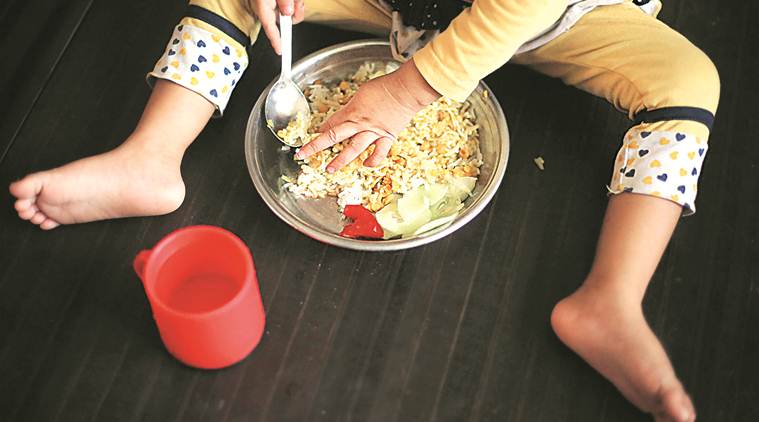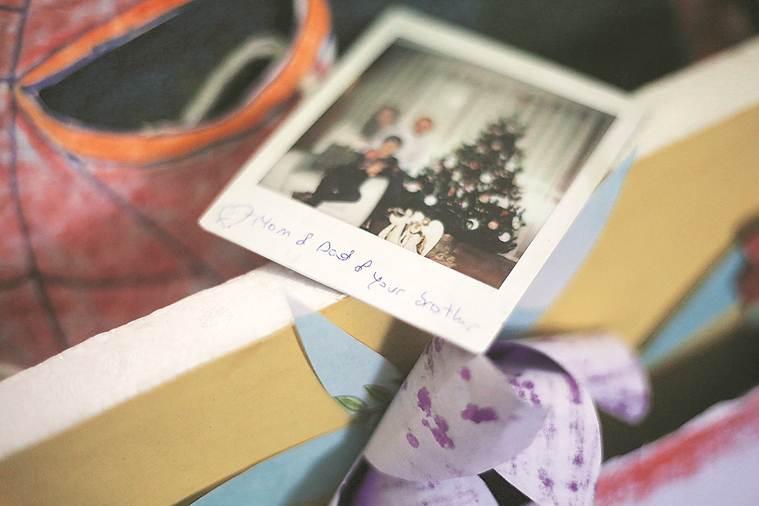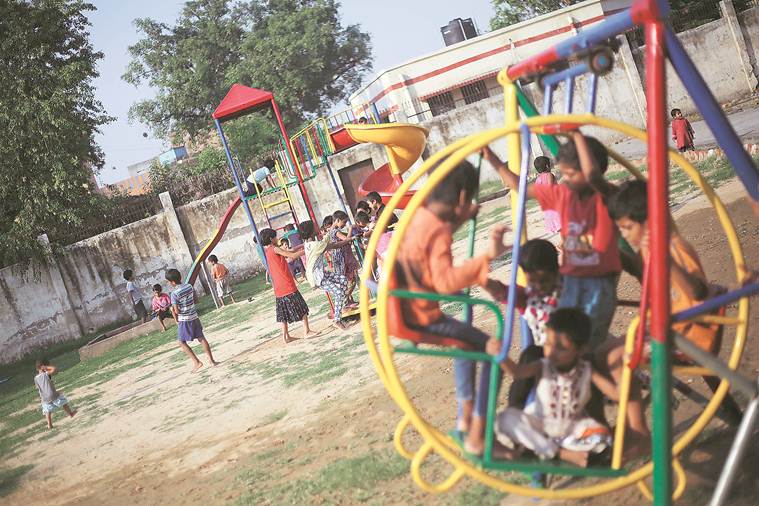
HOLDING an arm and index finger out, pointing towards a gate, Gudiya coaxes the caretaker of a government-run child care home in west Uttar Pradesh to take her to her favourite person, the home guard posted there.
Seeing the woman dressed in a khaki uniform, the toddler jumps into her lap.
A month ago, it was another woman in a similar uniform who had taken care of her for nine days, after Gudiya was found in a sugarcane field in Baghpat, wounded and bleeding. A search revealed the decomposed body of a woman a few metres away.
While the woman is unidentified still, and the case remains stuck, police believe she was the mother of the child. With little to go on, including the child’s name, they estimate her age to be around two, and have christened her Gudiya, or doll.
At the children’s home, it is not hard to see why. With her long, curled eyelashes and wavy brown hair, Gudiya looks like one, though her face and head still bear the scars and wounds of the violence she survived.
It was early morning on a Friday, May 17, that a group of villagers visiting a dargah for prayers were startled by the faint wail of a child. They looked around the sugarcane field nearby, situated close to the road that leads to the main Baghpat city, and discovered Gudiya. Just 50 metres away lay a woman with her face decomposed beyond recognition and bearing wounds similar to that of the child.
READ | Lost in Baghpat field for 4 days, a 1-year-old survives hunger, wounds
The villagers visiting the shrine called for an ambulance and the village head informed the police. But the horrors of what Gudiya may have gone through kept unfolding over the next 24 hours, as doctors at the Aastha Multi-Speciality Hospital in Baghpat, where she was taken, estimated that her wounds may have been inflicted four days ago.
Gudiya was found to have been attacked with a sharp object on the head and side of her face, her wounds deep enough to have impacted her skull. The woman next to her had stab injuries. Police concluded that the attack had taken place somewhere else and the two had been dumped in the field. The assaulters perhaps never expected the toddler to survive her injuries.
Gudiya would prove them wrong — as she continues to do again and again since.
Doctors believe Gudiya remained unconscious for most of the time she lay in the field, possibly due to a heat stroke from temperatures hovering around 40 degrees Celsius at the time. Then came the rain, and consequently maggots. The worms are believed to have infested the dead woman’s open wounds, leading to the decomposition, and attacked the bleeding flesh on Gudiya’s face as well as the skin close to her pelvis.
Gudiya fought on, including against four days of hunger and thirst.
Dr Ajay Garg of Aastha Multi-Speciality Hospital says, “It appears that she woke up at some point and began crawling. It is possible she was dehydrated and wanted water.”
He adds that the timing of when she was found was propitious too. “The wounds had begun to rot and any delay could have been fatal. The child has good immunity which helped her survive without food and water for so many days, especially under such circumstances.”
In the register maintained at the home, Gudiya’s date of birth was put down as June 28, 2017 — the date that she was brought to the centre by Child Welfare Committee officials, the year from two years ago.
***
At the hospital, Gudiya was attached to intravenous drips feeding her water and iodine. Lying on the mattress, she slept for hours as hospital staff made a beeline for the first-floor ward to catch a glimpse of the “miracle child”. She woke up only the next day — with Rekha Nagar next to her.
As it opened investigation into the case, police assigned the constable belonging to the Baraut Police Station to take care of Gudiya. Within days, Nagar and Gudiya were inseparable.

“When Gudiya woke up, a nurse offered her a small bottle of water. She drank it all up as she was so thirsty. She did the same with a bottle of milk. But when nurses came to change her diaper or clothes, she resisted. She appeared to be in trauma and have issues trusting people. I started sleeping next to her on the same bed and patted her slowly to convey she was safe,” says Nagar.
A mother of a five-year-old, Nagar says she didn’t mind spending up to 12 hours a day with Gudiya. The little girl felt like her own child, she adds.
A month on, Gudiya is more friendly than most children her age. She clings on to anyone who picks her up at the centre.
The children’s home starts stirring to life around 7 am. Sharing a room with 10 girls between the ages of 15 days and three years — including two premature babies — and a 15-day-old baby boy, Gudiya wakes up rubbing her eyes. In no time, she is in the lap of one of the two caretakers, who bathes and feeds her, and is by her side almost at all times.
The woman is hearing impaired, and Gudiya hasn’t started talking, which is a niggling worry for officials. Despite it or maybe because of it, the two have become close.
The other caretaker adds that the trauma Gudiya went through has left few unmoved at the centre, just like at the hospital. So, from everyone, she gets that little extra attention, the caretaker says.
Apart from the 15 toddlers, spread over two rooms (separate for boys and girls), the centre has 36 other children, till the age of 10. The 51 children are looked after by two caretakers at all times in shifts of eight hours each. A home guard sits at the gate and a nurse carries out periodic checks. A cook comes in at 7 am and makes breakfast, lunch, snacks and dinner.
The older children too are distributed across two rooms. All rooms have coolers and fans, but on a hot afternoon, the children are sprawled out on the cool marble floor.
Adjacent to the sleeping area is the entertainment room where children spend most of their time. Common toilets, a kitchen and dining area and two classrooms make up the rest of the ground floor, in the middle of which a courtyard is used for playing cricket. On the first floor are 10 other rooms, in two of which the caretakers live.
***
Soon, it is time for breakfast, where children are served an egg and a glass of milk each. While infants are fed milk from a bottle, the toddlers waddle into the dining room supervised by the older children.
The eldest five, each 10 years old, make sure the toddlers are the first ones to be fed. Since they can fall off the high benches, they are seated on the floor. The older children eat at the table.
Gudiya is a newcomer, but children make friends easily at the home. And consensus is uniform, among caretakers as well as the children, that Gudiya, despite not speaking, knows how to get her way. However, she barely smiles or laughs, even as children around her play or watch TV.
“She comes and sits next to me for hours sometimes. There is a mango tree in the yard and this is the time when unripe mangoes fall to the ground. They are neither too sour nor very sweet. She loves them. I try to make her laugh, tell her stories, but never has she broken into a smile. She is usually lost in her own world. Maybe it is a sad one. With the trauma she has undergone, I am not surprised,” the home guard says.
The 47-year-old says she has two children of own, a daughter who is married and a son who is studying. As she picks up Gudiya who is seeking to be lifted, she corrects that. “My daughter recently had a child. I am a grandmother now.”
The child care home is located next to an intermediate college (up to Class 12), and only recently a wall came up between the two. The home guard has to constantly ensure that the gate in the wall is bolted, so that the older children at the centre don’t run away.
***
While Gudiya’s case has caught the attention of everybody, tragedies like hers are not new to the centre. A few weeks before Gudiya arrived, a six-month-old girl had been brought to the centre by Sambhal police. She was found next to the bodies of her mother and older brother. The father, the accused, is now in police custody.
But unlike the infant’s case, Gudiya’s is no closer to a breakthrough. The heat, rains, maggots, all contributed to the destruction of any leads police may have lifted from the site where she was found. With little to go on, they are banking on a picture of her presumed mother’s decomposed face, the greenish suit she was wearing, and Gudiya.

“No ID was found on either the woman or the child. The post-mortem report says the body was found a week after the woman died. This rules out a lot of biological information we could have retrieved. I have personally visited the gram pradhans of every Baghpat village and shown them Gudiya’s picture for possible identification, but to no avail,” says Dharmendra Sandhu, the initial investigating officer (IO) in the case. Since he was made the Station House Officer of another police station, a new IO, Jahid Khan, has been appointed. “We have put up posters on social media and on walls. We have even extended our search to the NCR region, but no clue has been obtained,” says Rakesh Kumar Singh, SHO, Baraut.
Police say they could not conduct a DNA test on the woman to determine if she was related to Gudiya as her body was too decomposed. So she was cremated within 72 hours of being found.
Sandhu says police are looking at all angles. “There is a possibility the two lived in a different region and were dumped here. People in Baghpat district have been questioned extensively. We increased our investigation radius to 150 km but nothing turned up. Another problem is that there is no missing person’s complaint at the region’s police stations that matches the description of the two,” the SHO says.
Gudiya is police’s strongest lead. But no one has come forward to claim her so far.
***
At the children’s home, as the clock strikes noon, the cook, an elderly woman referred to by everyone as “Cook Aunty”, is putting the final touches on a meal of rice, daal and sambhar, with lots of vegetables.
Gudiya is hungry and, like everyone at the centre attests, makes her wishes clear. She screeches and kicks till she is led to the dining room. The cook lifts her up and puts her on the counter, besides the vessels holding food for the 51 children and the staff members.
The cook selects a thaali with raised edges and places a small heap of rice on it. As Gudiya looks on, she pours a ladle of daal over the rice and places slices of cucumber and tomatoes besides it. Gudiya sits down to eat, with a red tumbler holding water next to her. While a small herd of goats outside the window briefly distracts her, she has no interest in the TV that is on, unlike the other children.
When she arrived at the centre, Gudiya weighed 8.5 kg, 3.5 kg below the median weight for a two-year-old, as per WHO parametres. Her current weight will soon be taken as part of the monthly check for weight and height.
The antibiotics that the doctors started her on in the hospital were continued for only about a week at the centre. Now, apart from ointments for her scars, Gudiya is given only multi-vitamins and calcium.
None of the children at the centre goes to school, but two teachers come and teach them. “We aren’t sure if sending the kids out to study is safe. We don’t have any means of transport,” says the director, who has been posted at the centre for three years.
Referring to Gudiya, he says, “She has been with us for a month and is healthy. She is active and is making friends.” Also using the word ‘miracle’ to describe her story, he adds, “It just proves that if God doesn’t want you to die, no one can harm you.”
***
Miracles, few contest, are rare at the centre, which houses children either orphaned or abandoned by their parents, and who spend years waiting to find a “forever family”. The home is an adoption centre registered with the Central Adoption Resource Authority (CARA), a unified umbrella for adoption process in the country.
The director has markers and souvenirs of successful adoption stories at the centre under a glass top on his work table. A note below a photograph reads “Mom, Dad and your brother”. It was sent by a seven-year old, from Spain, where he now lives with his adoptive family.
“So far, eight children under my tenure here since 2016 have been adopted by families abroad. America, Spain, France, parents have come to us from different parts of the world. It is these families who adopt differently abled children and those older than three years. In our country, everyone wants a fair and young child,” he says.
At the centre, 24 parents are in the waiting list for adoption (centrally, the number of applicants is higher compared to the children up for adoption). “Most of them want a girl child, though under the age of three. We have 15 children under that age,” he says.
The oldest child ever adopted from the home was an eight-year-old boy, who also lives in Spain now.
For Gudiya, the possibility of adoption opens up after two months. Now that she is better, the government has put out advertisements in national newspapers looking for a family member to claim her. If there is no response in 60 days, Gudiya will be put up for adoption.
“We don’t disclose the identity or the case background of children to prospective parents, but even without her back story, Gudiya will be adopted very soon I think. She has an angelic face,” the director says.
As the sun sets slowly, a cool breeze rolls in, providing relief from the humidity. One by one, the children emerge for their scheduled play-time, and take over the three swings and an open space, while preparations begin for a cricket match. Two children lie in the shade of the mango tree, munching on the fallen mangoes.
Still struggling to rouse herself from her afternoon siesta, Gudiya is not among the children. But soon she is standing close to the gate, ignoring the children who are calling out her name, looking around for the home guard.
Could the “miracle child” see perhaps another miracle? Communicating with gestures, Gudiya’s caretaker says she doesn’t like milk and keeps asking for water. Gudiya also keeps repeating one word —the only word they have heard her speak at the centre — “Maa”.
(The Sunday Express is not revealing the location of the child, or of the officials part of her story, to protect her privacy)